TOYOTA PRIUS V 2017 ZVW40 / 1.G Owners Manual
Manufacturer: TOYOTA, Model Year: 2017, Model line: PRIUS V, Model: TOYOTA PRIUS V 2017 ZVW40 / 1.GPages: 624, PDF Size: 13.82 MB
Page 231 of 624
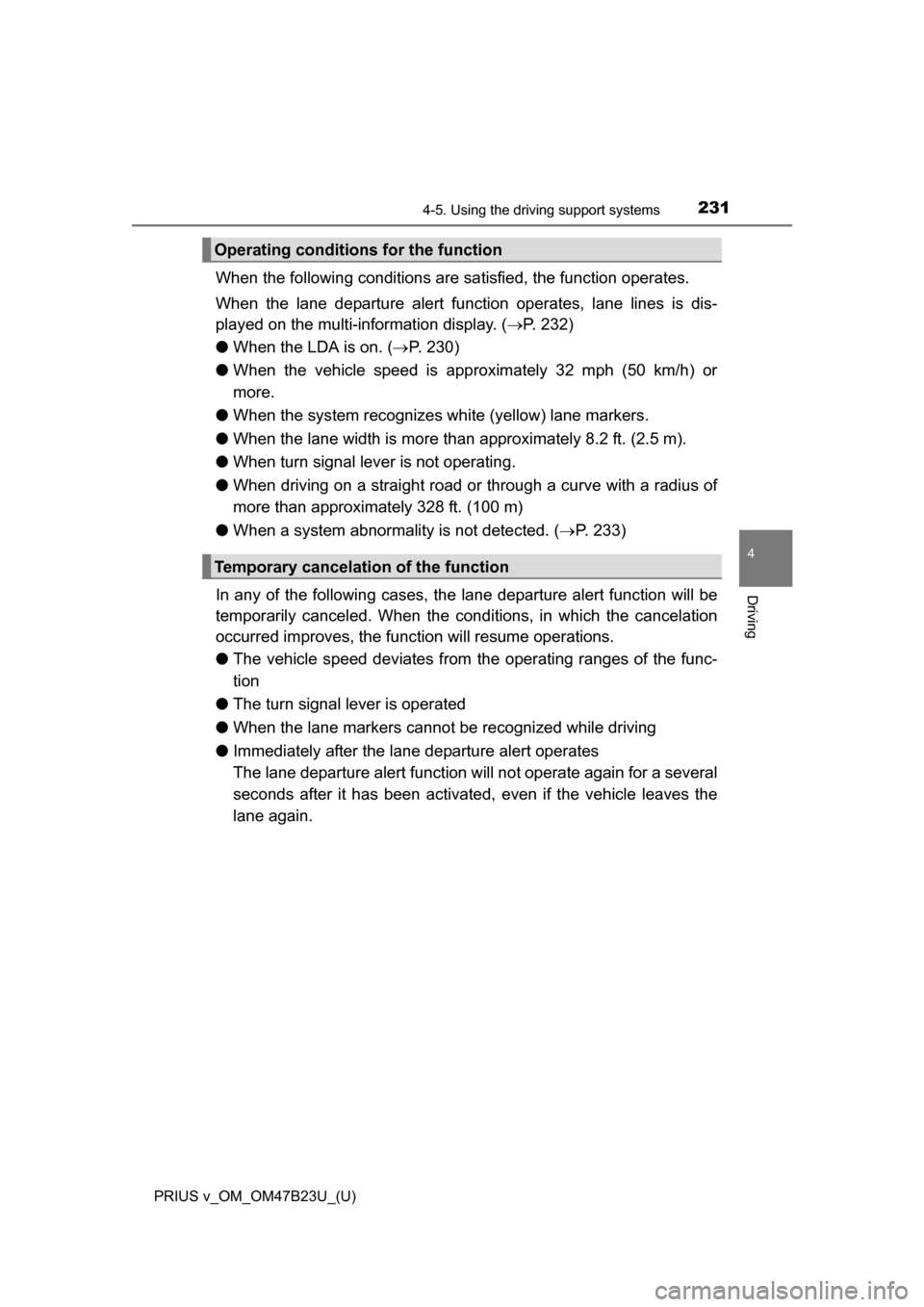
PRIUS v_OM_OM47B23U_(U)
2314-5. Using the driving support systems
4
Driving
When the following conditions are sa tisfied, the function operates.
When the lane departure alert function operates, lane lines is dis-
played on the multi-information display. ( P. 232)
● When the LDA is on. ( P. 230)
● When the vehicle speed is approximately 32 mph (50 km/h) or
more.
● When the system recognizes white (yellow) lane markers.
● When the lane width is more than approximately 8.2 ft. (2.5 m).
● When turn signal lever is not operating.
● When driving on a straight road or through a curve with a radius of
more than approximately 328 ft. (100 m)
● When a system abnormality is not detected. ( P. 233)
In any of the following cases, the lane departure alert function will be
temporarily canceled. When the cond itions, in which the cancelation
occurred improves, the functi on will resume operations.
● The vehicle speed deviates from the operating ranges of the func-
tion
● The turn signal lever is operated
● When the lane markers cannot be recognized while driving
● Immediately after the lane departure alert operates
The lane departure alert function w ill not operate again for a several
seconds after it has been activated, even if the vehicle leaves the
lane again.
Operating conditions for the function
Temporary cancelation of the function
Page 232 of 624
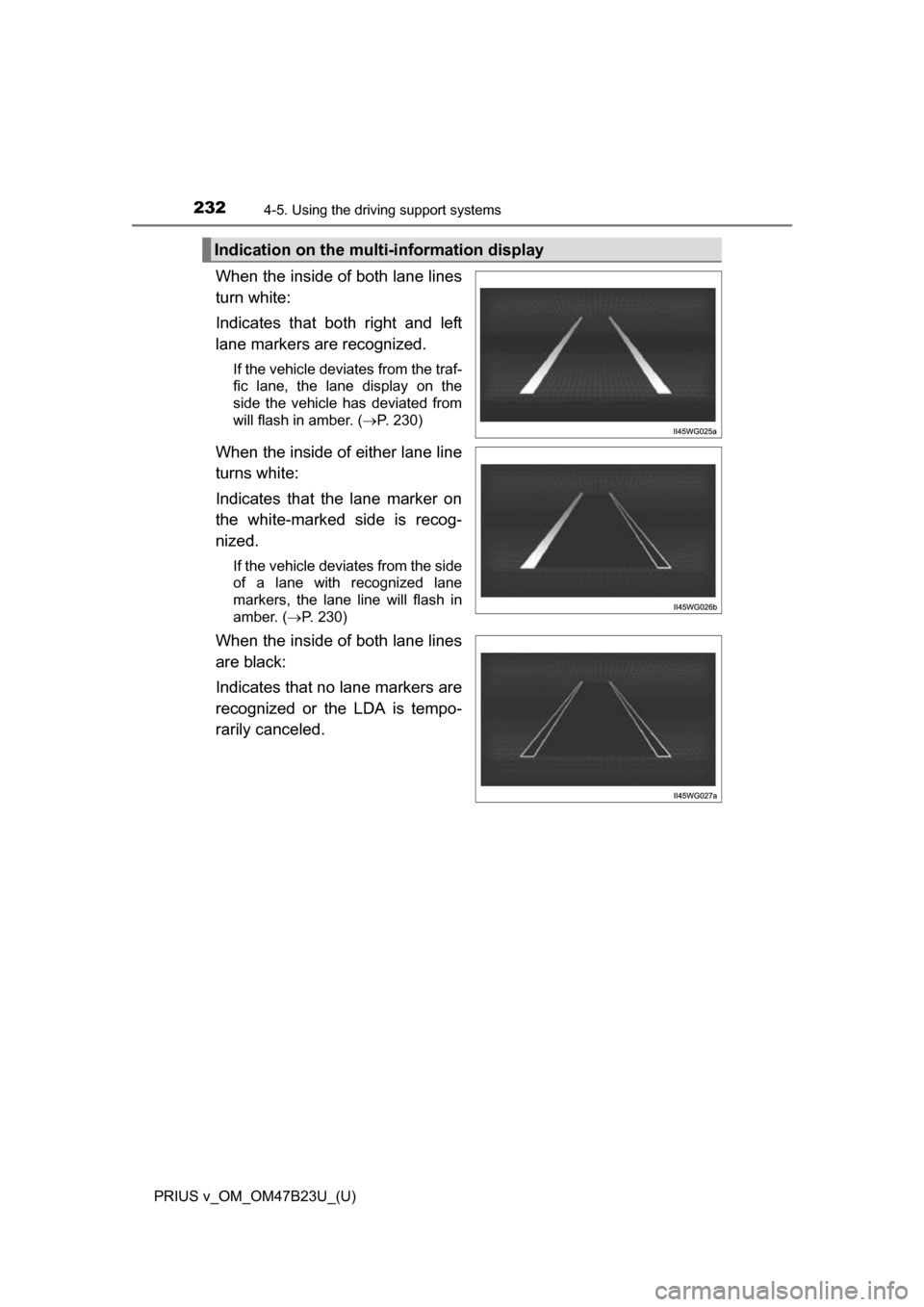
232
PRIUS v_OM_OM47B23U_(U)
4-5. Using the driving support systems
When the inside of both lane lines
turn white:
Indicates that both right and left
lane markers are recognized.
If the vehicle deviates from the traf-
fic lane, the lane display on the
side the vehicle has deviated from
will flash in amber. ( P. 230)
When the inside of either lane line
turns white:
Indicates that the lane marker on
the white-marked side is recog-
nized.
If the vehicle deviates from the side
of a lane with recognized lane
markers, the lane line will flash in
amber. (P. 230)
When the inside of both lane lines
are black:
Indicates that no lane markers are
recognized or the LDA is tempo-
rarily canceled.
Indication on the multi-information display
Page 233 of 624
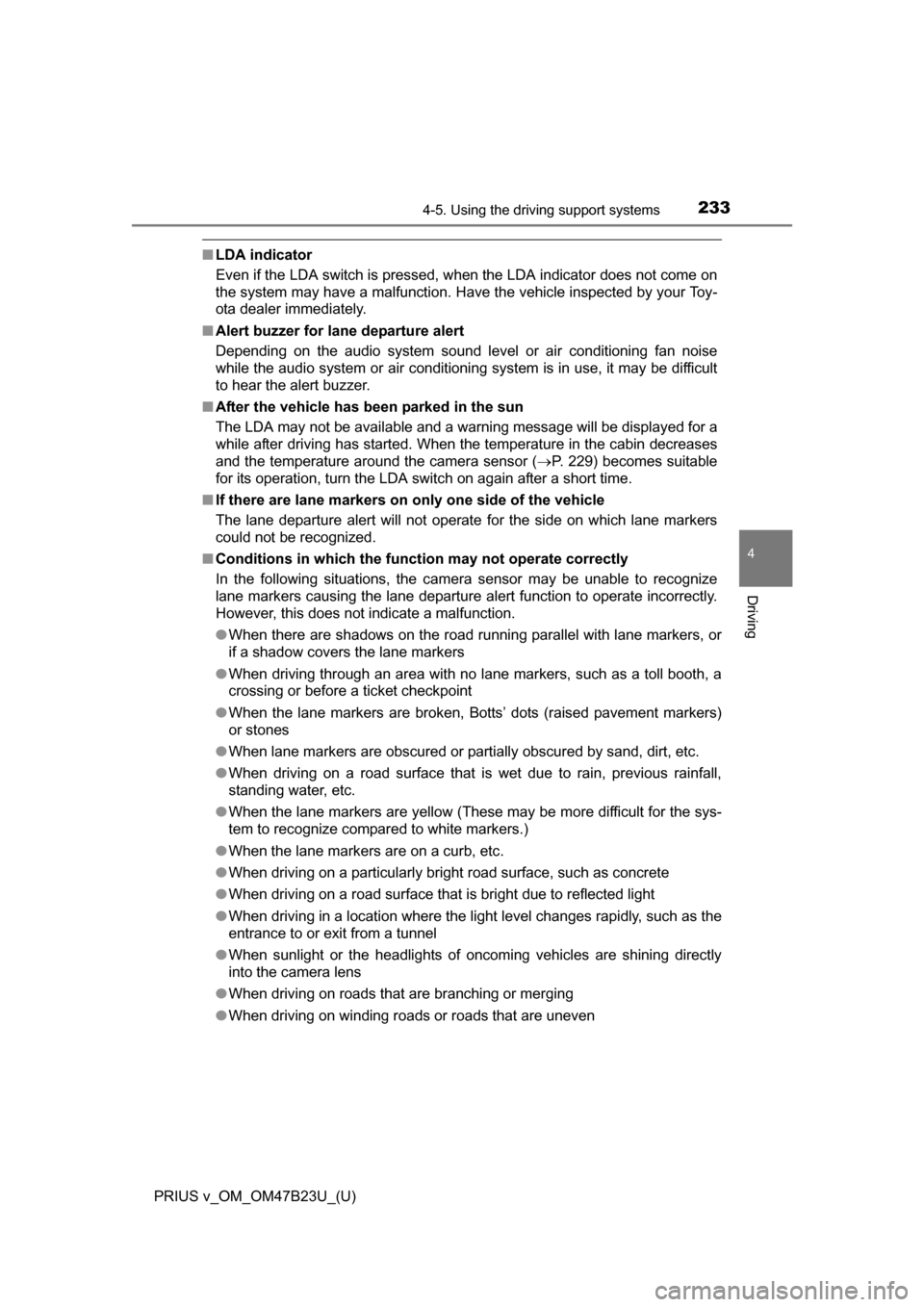
PRIUS v_OM_OM47B23U_(U)
2334-5. Using the driving support systems
4
Driving
■LDA indicator
Even if the LDA switch is pressed, when the LDA indicator does not come on
the system may have a malfunction. Have the vehicle inspected by your Toy-
ota dealer immediately.
■ Alert buzzer for lane departure alert
Depending on the audio system sound level or air conditioning fan noise
while the audio system or air conditioning system is in use, it may be difficult
to hear the alert buzzer.
■ After the vehicle has been parked in the sun
The LDA may not be available and a warning message will be displayed for a
while after driving has started. When the temperature in the cabin decreases
and the temperature around the camera sensor ( P. 229) becomes suitable
for its operation, turn the LDA switch on again after a short time.
■ If there are lane markers on only one side of the vehicle
The lane departure alert will not operate for the side on which lane markers
could not be recognized.
■ Conditions in which the function may not operate correctly
In the following situations, the camera sensor may be unable to recognize
lane markers causing the lane departure alert function to operate incorrectly.
However, this does not indicate a malfunction.
●When there are shadows on the road running parallel with lane markers, or
if a shadow covers the lane markers
● When driving through an area with no lane markers, such as a toll booth, a
crossing or before a ticket checkpoint
● When the lane markers are broken, Botts’ dots (raised pavement markers)
or stones
● When lane markers are obscured or partially obscured by sand, dirt, etc.
● When driving on a road surface that is wet due to rain, previous rainfall,
standing water, etc.
● When the lane markers are yellow (These may be more difficult for the sys-
tem to recognize compared to white markers.)
● When the lane markers are on a curb, etc.
● When driving on a particularly bright road surface, such as concrete
● When driving on a road surface that is bright due to reflected light
● When driving in a location where the light level changes rapidly, such as the
entrance to or exit from a tunnel
● When sunlight or the headlights of oncoming vehicles are shining directly
into the camera lens
● When driving on roads that are branching or merging
● When driving on winding roads or roads that are uneven
Page 234 of 624
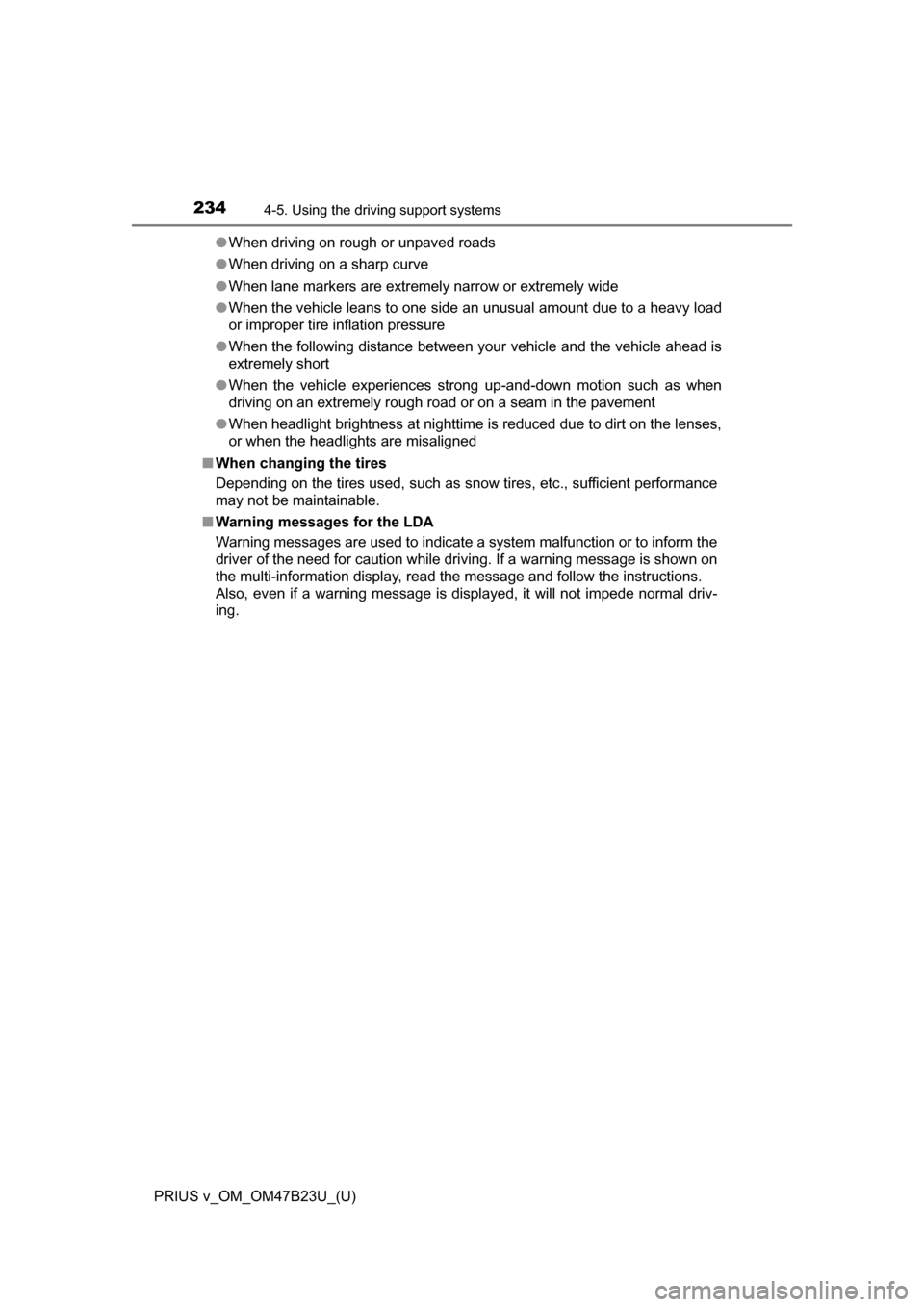
234
PRIUS v_OM_OM47B23U_(U)
4-5. Using the driving support systems
●When driving on rough or unpaved roads
● When driving on a sharp curve
● When lane markers are extremely narrow or extremely wide
● When the vehicle leans to one side an unusual amount due to a heavy load
or improper tire inflation pressure
● When the following distance between your vehicle and the vehicle ahead is
extremely short
● When the vehicle experiences strong up-and-down motion such as when
driving on an extremely rough road or on a seam in the pavement
● When headlight brightness at nighttime is reduced due to dirt on the lenses,
or when the headlights are misaligned
■ When changing the tires
Depending on the tires used, such as snow tires, etc., sufficient performance
may not be maintainable.
■ Warning messages for the LDA
Warning messages are used to indicate a system malfunction or to inform t\
he
driver of the need for caution while driving. If a warning message is sh\
own on
the multi-information display, read the message and follow the instructions.
Also, even if a warning message is displayed, it will not impede normal driv-
ing.
Page 235 of 624
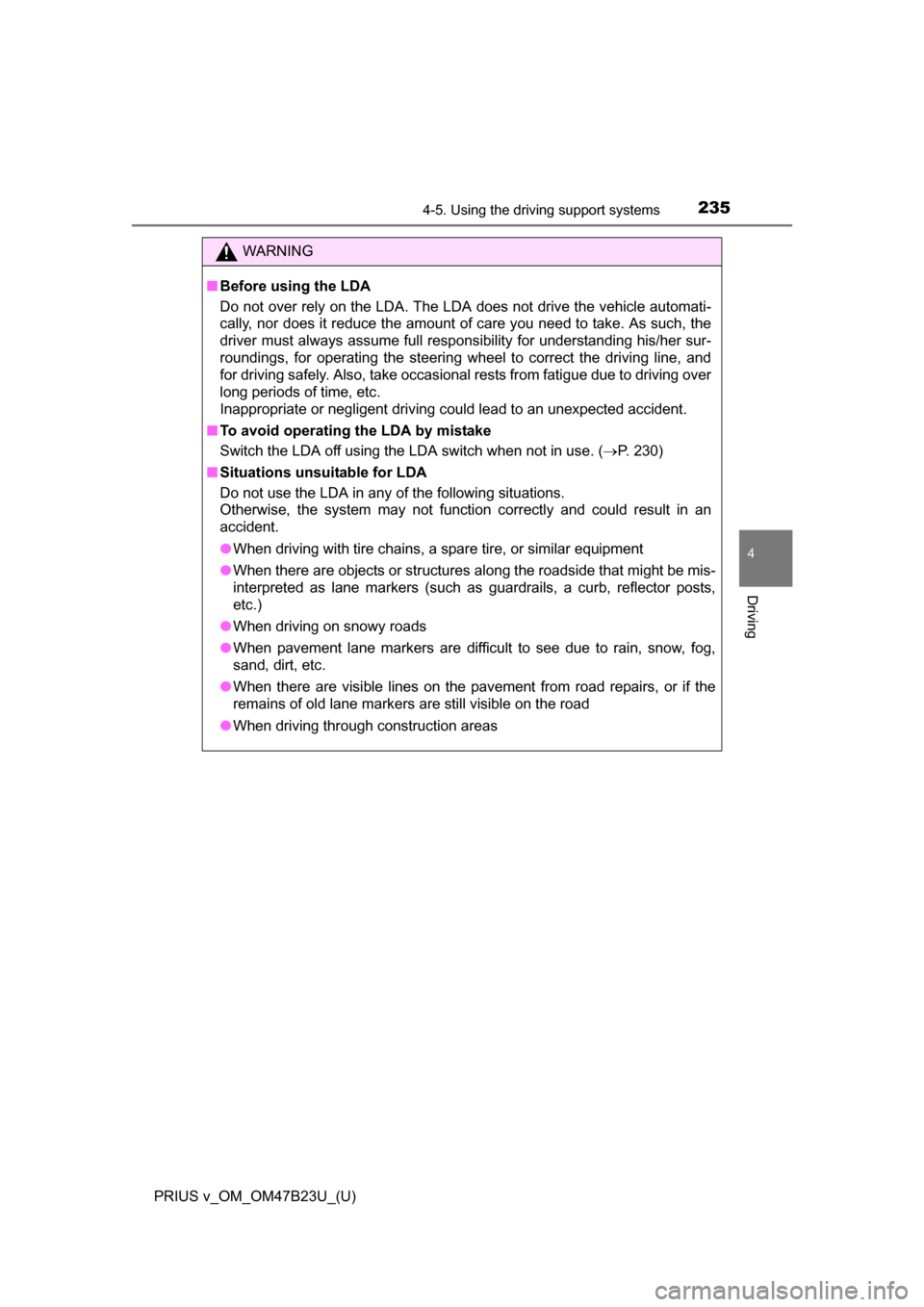
PRIUS v_OM_OM47B23U_(U)
2354-5. Using the driving support systems
4
Driving
WARNING
■Before using the LDA
Do not over rely on the LDA. The LDA does not drive the vehicle automati-
cally, nor does it reduce the amount of care you need to take. As such, the
driver must always assume full responsibility for understanding his/her sur-
roundings, for operating the steering wheel to correct the driving line, and
for driving safely. Also, take occasional rests from fatigue due to driving over
long periods of time, etc.
Inappropriate or negligent driving could lead to an unexpected accident.
■ To avoid operating the LDA by mistake
Switch the LDA off using the LDA switch when not in use. ( P. 230)
■ Situations unsuitable for LDA
Do not use the LDA in any of the following situations.
Otherwise, the system may not function correctly and could result in an
accident.
●When driving with tire chains, a spare tire, or similar equipment
● When there are objects or structures along the roadside that might be mis-
interpreted as lane markers (such as guardrails, a curb, reflector posts,
etc.)
● When driving on snowy roads
● When pavement lane markers are difficult to see due to rain, snow, fog,
sand, dirt, etc.
● When there are visible lines on the pavement from road repairs, or if the
remains of old lane markers are still visible on the road
● When driving through construction areas
Page 236 of 624
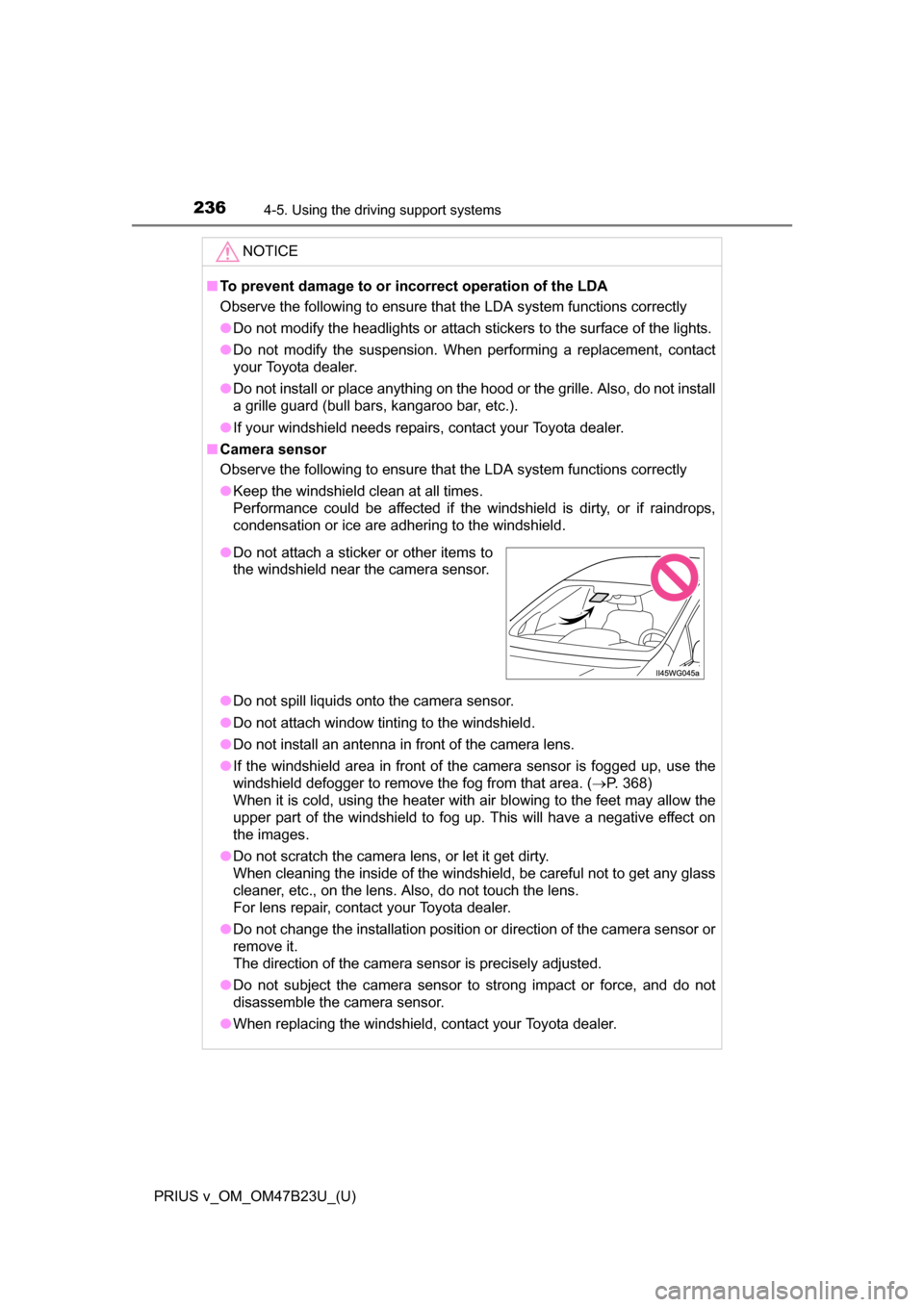
236
PRIUS v_OM_OM47B23U_(U)
4-5. Using the driving support systems
NOTICE
■To prevent damage to or incorrect operation of the LDA
Observe the following to ensure that the LDA system functions correctly
●Do not modify the headlights or attach stickers to the surface of the lights.
● Do not modify the suspension. When performing a replacement, contact
your Toyota dealer.
● Do not install or place anything on the hood or the grille. Also, do not install
a grille guard (bull bars, kangaroo bar, etc.).
● If your windshield needs repairs, contact your Toyota dealer.
■ Camera sensor
Observe the following to ensure that the LDA system functions correctly
●Keep the windshield clean at all times.
Performance could be affected if the windshield is dirty, or if raindrops,
condensation or ice are adhering to the windshield.
● Do not spill liquids onto the camera sensor.
● Do not attach window tinting to the windshield.
● Do not install an antenna in front of the camera lens.
● If the windshield area in front of the camera sensor is fogged up, use the
windshield defogger to remove the fog from that area. ( P. 368)
When it is cold, using the heater with air blowing to the feet may allow the
upper part of the windshield to fog up. This will have a negative effect on
the images.
● Do not scratch the camera lens, or let it get dirty.
When cleaning the inside of the windshield, be careful not to get any glass
cleaner, etc., on the lens. Also, do not touch the lens.
For lens repair, contact your Toyota dealer.
● Do not change the installation position or direction of the camera sensor or
remove it.
The direction of the camera sensor is precisely adjusted.
● Do not subject the camera sensor to strong impact or force, and do not
disassemble the camera sensor.
● When replacing the windshield, contact your Toyota dealer.
●Do not attach a sticker or other items to
the windshield near the camera sensor.
Page 237 of 624
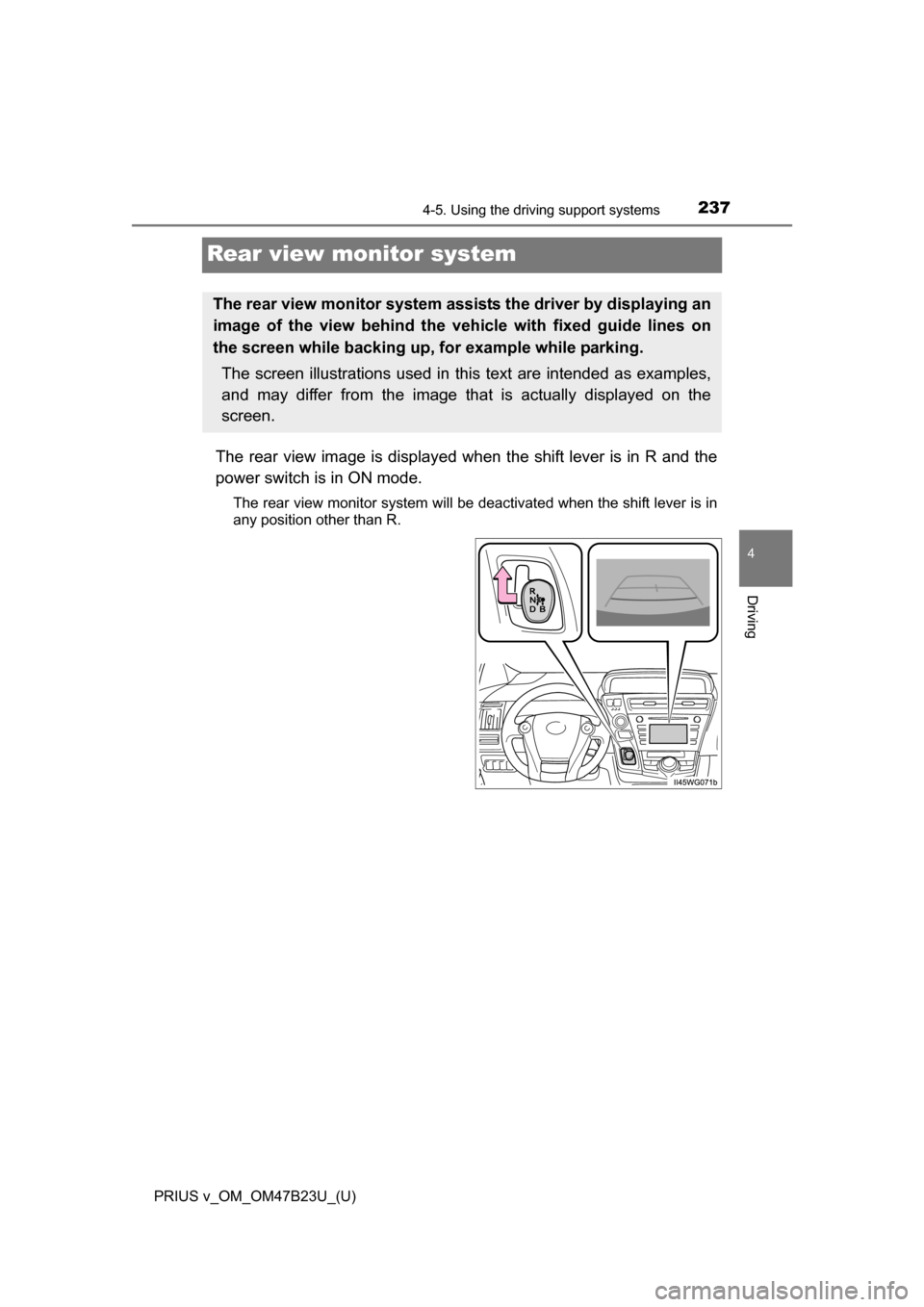
237
PRIUS v_OM_OM47B23U_(U)
4-5. Using the driving support systems
4
Driving
Rear view monitor system
The rear view image is displayed when the shift lever is in R and the
power switch is in ON mode.
The rear view monitor system will be deactivated when the shift lever is in
any position other than R.
The rear view monitor system assists the driver by displaying an
image of the view behind the veh icle with fixed guide lines on
the screen while backing up, for example while parking.
The screen illustrations used in this text are intended as examples,
and may differ from the image that is actually displayed on the
screen.
Page 238 of 624
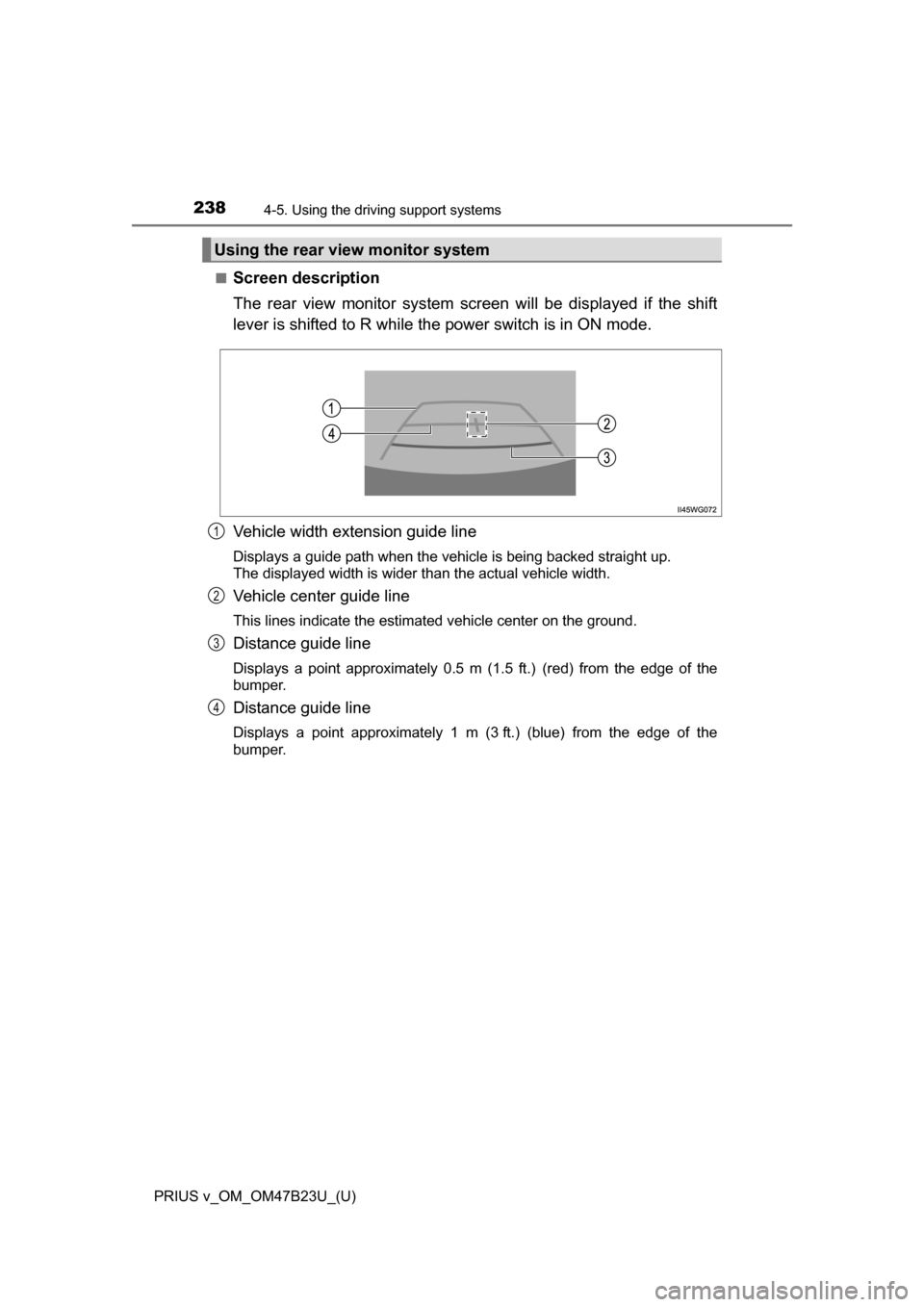
238
PRIUS v_OM_OM47B23U_(U)
4-5. Using the driving support systems
■Screen description
The rear view monitor system screen will be displayed if the shift
lever is shifted to R while the power switch is in ON mode.
Vehicle width extension guide line
Displays a guide path when the vehicle is being backed straight up.
The displayed width is wider than the actual vehicle width.
Vehicle center guide line
This lines indicate the estimated vehicle center on the ground.
Distance guide line
Displays a point approximately 0.5 m (1.5 ft.) (red) from the edge of the
bumper.
Distance guide line
Displays a point approximately 1 m (3 ft.) (blue) from the edge of the
bumper.
Using the rear view monitor system
1
2
3
4
Page 239 of 624
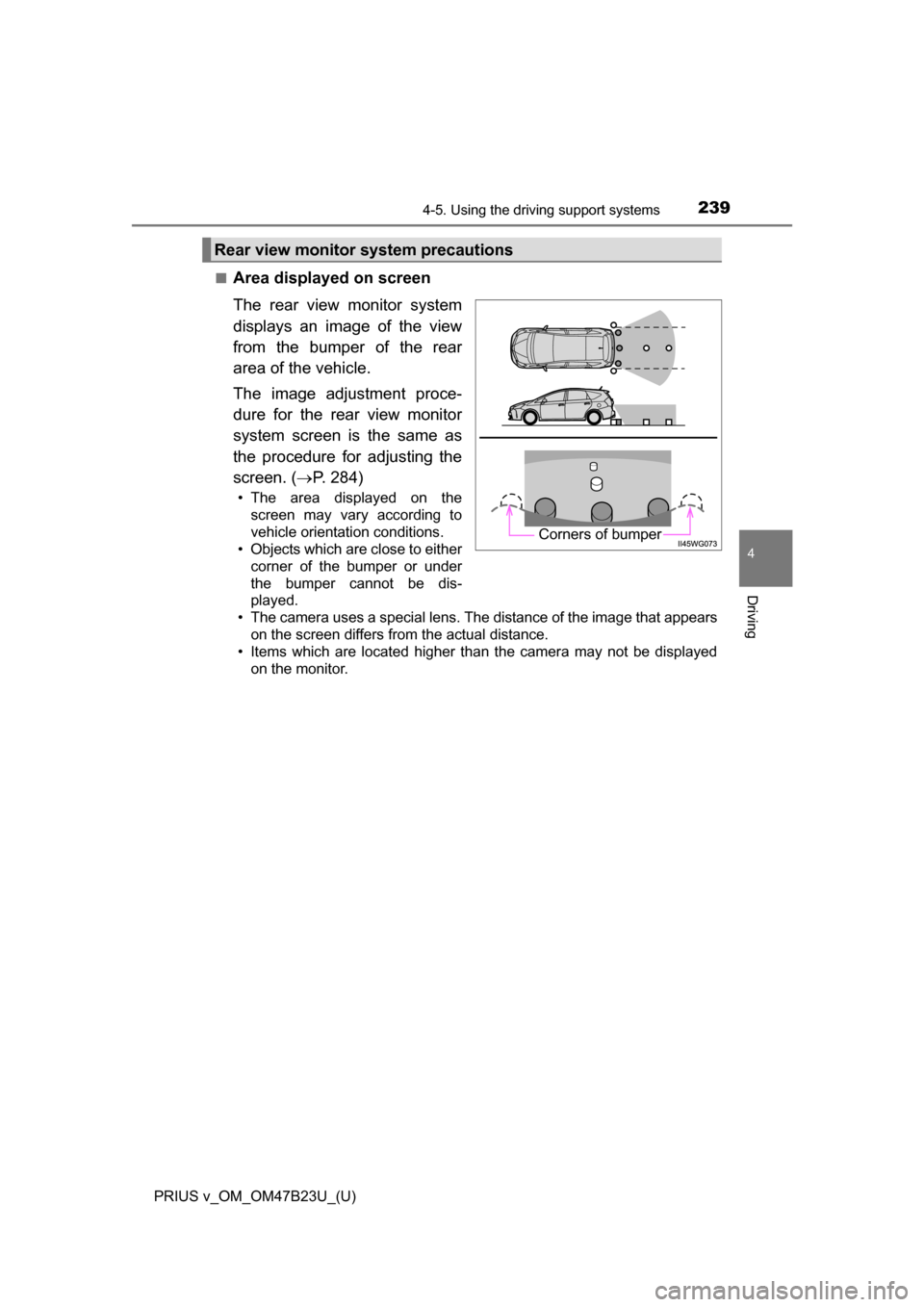
PRIUS v_OM_OM47B23U_(U)
2394-5. Using the driving support systems
4
Driving
■Area displayed on screen
The rear view monitor system
displays an image of the view
from the bumper of the rear
area of the vehicle.
The image adjustment proce-
dure for the rear view monitor
system screen is the same as
the procedure for adjusting the
screen. (P. 284)
• The area displayed on the
screen may vary according to
vehicle orientation conditions.
• Objects which are close to either corner of the bumper or under
the bumper cannot be dis-
played.
• The camera uses a special lens. The distance of the image that appears
on the screen differs from the actual distance.
• Items which are located higher than the camera may not be displayed on the monitor.
Rear view monitor system precautions
Corners of bumper
Page 240 of 624
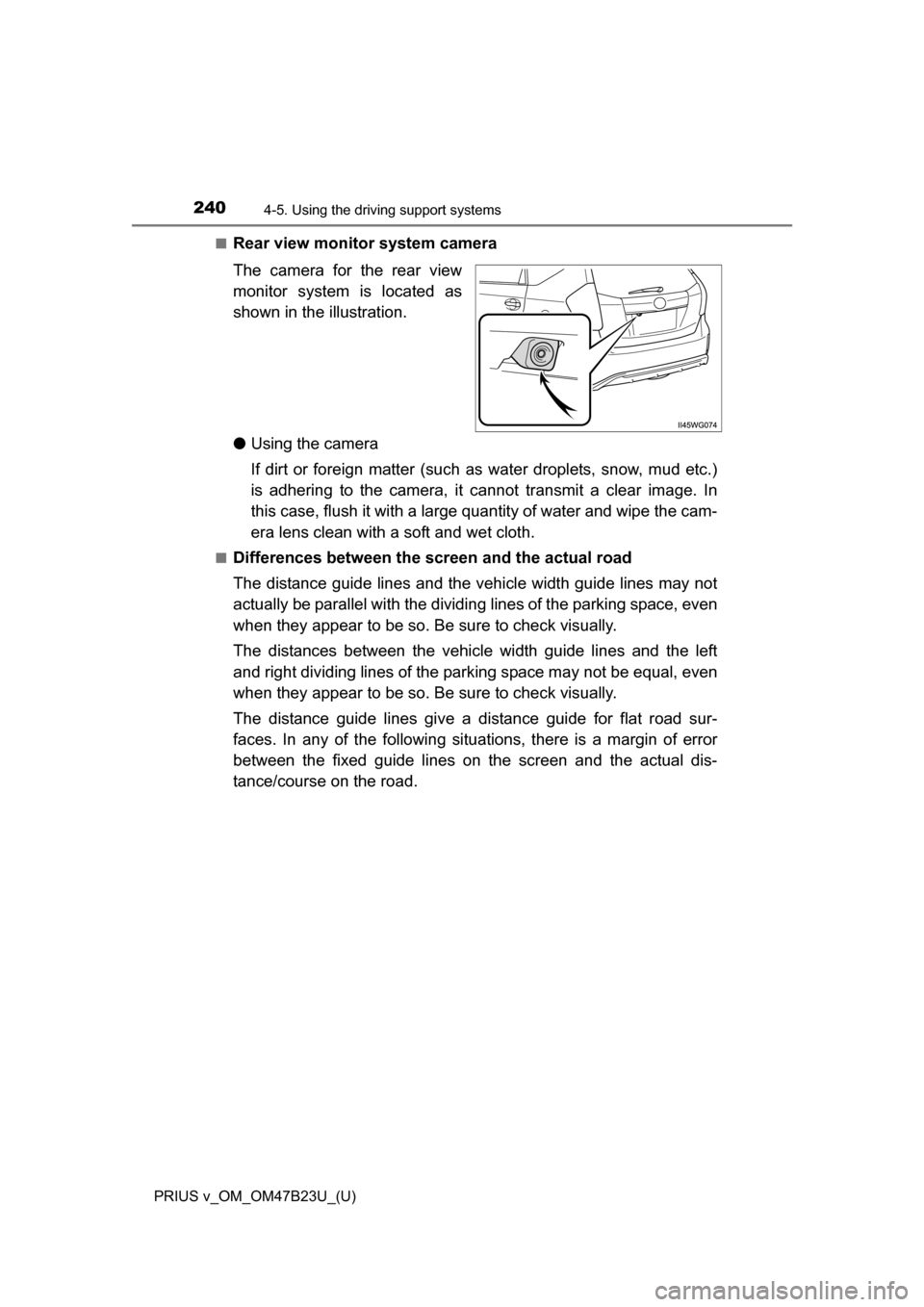
240
PRIUS v_OM_OM47B23U_(U)
4-5. Using the driving support systems
■Rear view monitor system camera
The camera for the rear view
monitor system is located as
shown in the illustration.
● Using the camera
If dirt or foreign matter (such as water droplets, snow, mud etc.)
is adhering to the camera, it cannot transmit a clear image. In
this case, flush it with a large quantity of water and wipe the cam-
era lens clean with a soft and wet cloth.
■Differences between the screen and the actual road
The distance guide lines and the vehicle width guide lines may not
actually be parallel with the dividing lines of the parking space, even
when they appear to be so. Be sure to check visually.
The distances between the vehicle width guide lines and the left
and right dividing lines of the pa rking space may not be equal, even
when they appear to be so. Be sure to check visually.
The distance guide lines give a distance guide for flat road sur-
faces. In any of the following situations, there is a margin of error
between the fixed guide lines on the screen and the actual dis-
tance/course on the road.